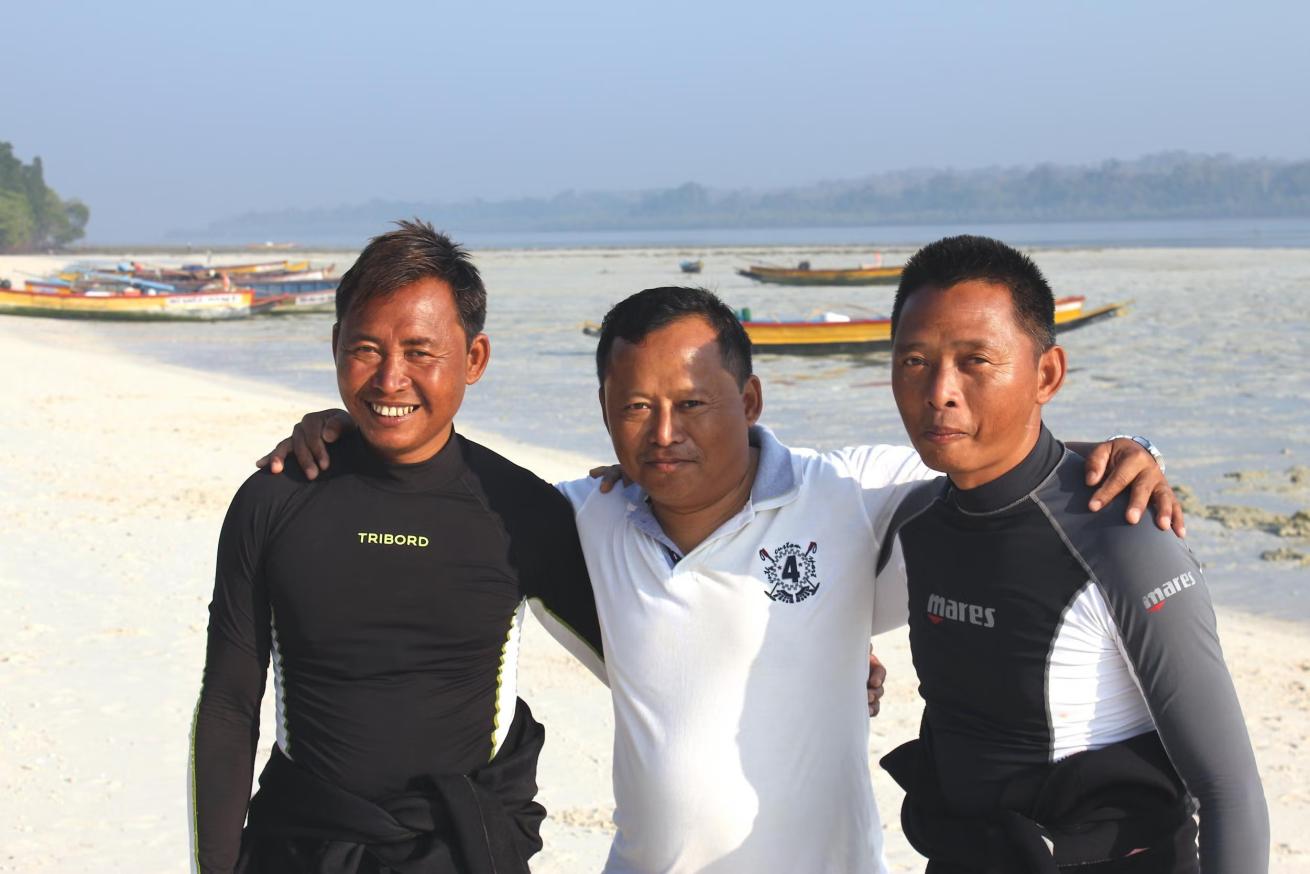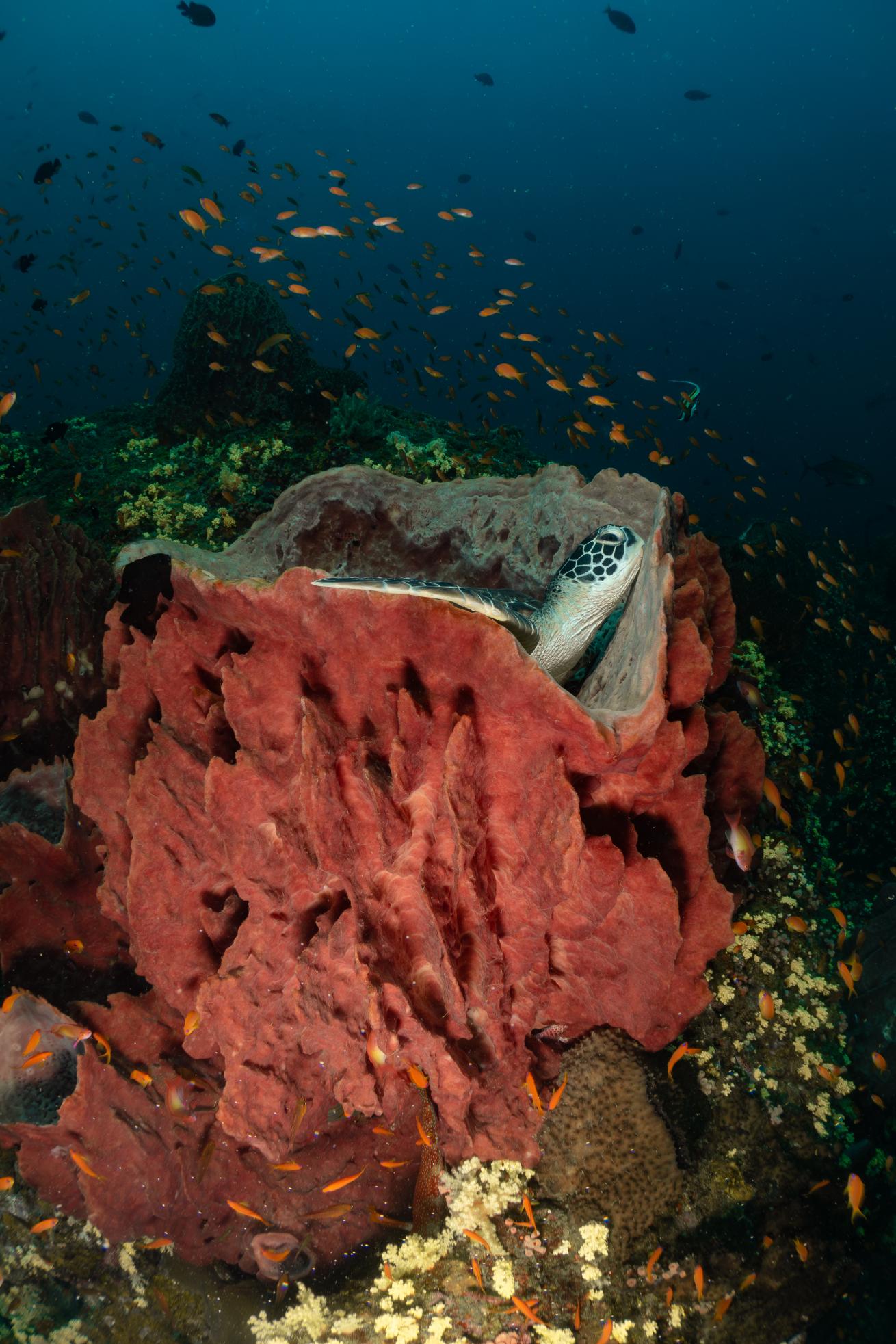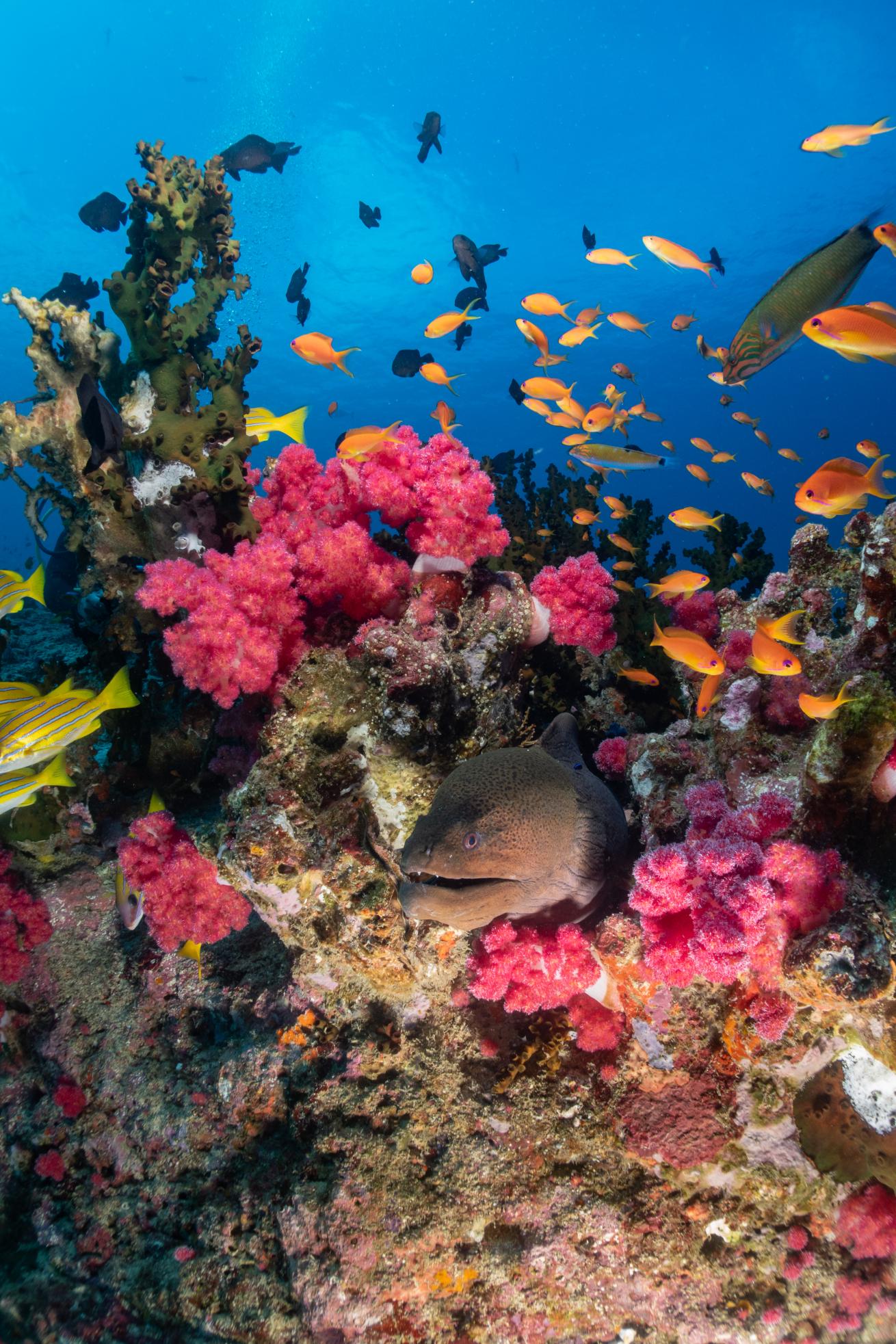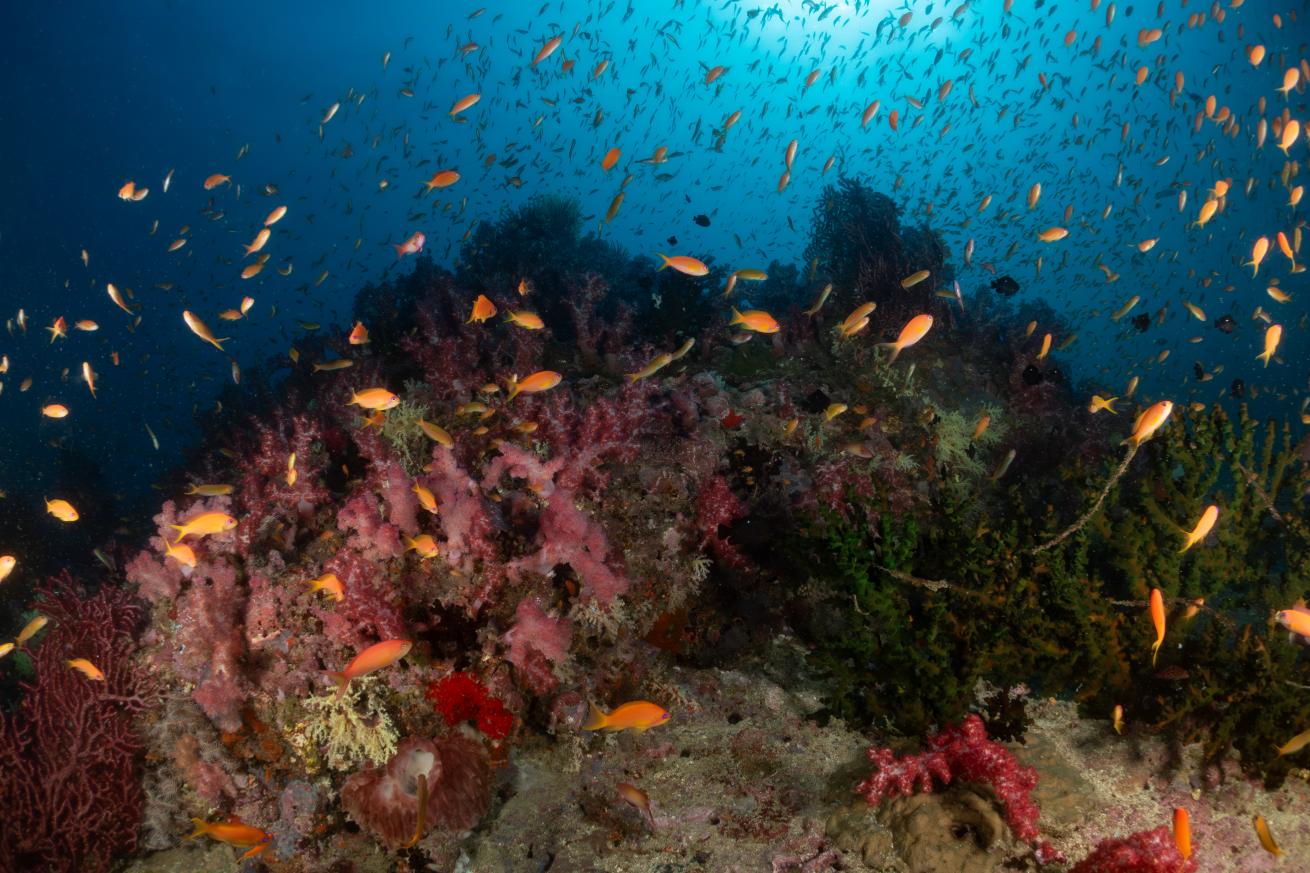How Three Brothers Put Havelock Island Diving on the Map

Poayasay BrothersJohnny, Dickson and Jackson Poayasay in Havelock
In 1989, when Jacques-Yves Cousteau went to the Andaman Islands in India aboard the Calypso as a part of a joint Indo-French exploration of marine life surrounding the islands, they were formally put on the diving map. Ever since, this region has emerged as India's prime diving destination, including three of the world’s most sought-after and bucket list–worthy diving sites—Johnny’s Gorge, Jackon’s Bar and Dickson’s Pinnacle, all close to tiny Havelock Island.
These sites are the namesakes of three brothers from Havelock Island’s Karen community, a Burmese tribe brought to the Andaman Islands by the British during the 1920s and 30s to work for the East India Company. The similarity in topography between Myanmar and the Andaman Islands meant the Karens were the perfect people to work in deep forests where diseases like malaria had otherwise killed hundreds of British officers.
Related Reading: Where to Go Scuba Diving in India
Today, the descendants of these Karen people are mainly concentrated around Mayabunder, on Middle Andaman island. While their primary occupations include farming and fishing, the Karens are best known for their underwater skills, which help with the latter. They are known to easily go under on a single breath to catch fish with traditional bamboo spears—without fins, masks or snorkels.
Taking after their Karen ancestors, the Poayesay brothers—Jackson, Dickson and Johnny—are no different. In 1998, Jackson, the middle brother, was the first of the three to be formally introduced to scuba diving. “I had heard of people going in the water with air cylinders and all that fancy gear. But I could never understand what it was,” he says. When a Swiss PADI Instructor, Herbert Burri, opened up the Andaman’s first dive shop on a beach called Chidiya Tapu, Johnny had his first tryst with the cylinders and fancy equipment he had heard so much about. “It was like discovering magic! I could never freedive very deep like my brothers, but scuba diving felt like a whole different world had opened for me.” Soon after, his brothers followed suit and became certified divers too.
While Burri had to close shop in 2003, serendipitously, Havelock’s first diving outfit, DIVEIndia, opened up around the same time. DIVEIndia’s founder, Vandit Kalia (known simply as Vinnie), not only received most of Burri’s scuba equipment but also his three best divers, Johnny, Jackson and Dickson. “We did a lot of exploratory dives with DIVEIndia. It was also here that we got our divemaster certifications,” Dickson recalls.

Kartikae GanjuA turtle enjoys some solice with a barrel sponge at Dixon's Pinnacle.
Back then, Minerva Ledge and The Wall were the only two dive sites known around the island, and the only divers who would come here were foreigners. “But the 2004 tsunami put the Andaman Islands on the tourist map,” Jackson says. “The news made people aware of these remote islands in their own country.” The Andaman Islands are closer to Southeast Asian countries like Thailand, Indonesia and Myanmar than the Indian mainland.
Much like Cousteau himself, the Poayesay brothers had the insatiable hunger of a curious mind. The fact that there existed the few already known dive sites around Havelock, made Johnny, Jackson and Dickson take the plunge into the search for the unknown and bring it out for the world to experience.
“We would do exploratory trips as far as North Andaman near Diglipur, sometimes around Long Island and often go south near Cinque and South Passage Islands,” Dickson reminisces. The brothers would simply hop onto a fisherman's dinghy and go wherever was suggested.
Spending so much time on the open sea, the fishermen can tell what formations lie below the surface without ever getting into the water. “That is actually how we found Dickson’s Pinnacle,” Dickson tells me with the same wonder in his eyes I imagine he had all those years ago on that small boat. Once, they noticed that the anchor went in and then slipped in deeper, suggesting a long, rocky formation that might be worth exploring. And it indeed was. Dickson’s Pinnacle was the first one to be put on the Havelock diving map in 2006 and is now known for its abundance of soft yellow corals with resident moray eels, eagle rays, barracudas, trevallies and many other species.
Related Reading: What to Know About the Fourth Global Coral Bleaching Event

Kartikae GanjuA moray eel among a vibrant reef at Johnny's Gorge.
Soon after, Johnny’s Gorge and Jackson’s Bar were introduced as well, each known for different things—from giant sponge corals to white tip reef sharks and currents just about right for drift diving.
At Johnny’s, there is not a single moment of lull with yellow, blue and silver schools of sweetlips, snappers, batfish and resident reef sharks and rays going about these low rocky outcrops surrounded by sand, while trevallies and barracudas circle overhead. Whereas, Jackson’s Bar with its flat rocky shelf is the perfect spot for a challenging dive where currents reward you with pelagic creatures like barracuda, tuna, reef sharks, eagle and mobula rays, and sometimes even manta rays.
“Diving in Havelock has changed a lot since we started,” Jackson recounts. In 2011, the brothers opened the island’s sixth dive shop, called Ocean Tribe. Today, there are over 35 diving outfits in Havelock, each listing Johnny’s Gorge, Dickson’s Pinnacle and Jackson’s Bar as top dive sites to explore in the region. These three diving sites have an almost cult-like following now. Most divers come to Havelock with a mission to dive at Jackson’s, Johnny’s or Dickson’s, but even if they don’t, others usually find their way to these prestigious sites eventually. It’s not just first-time visitors who find these dive sites compelling. The sites continue to dazzle even for those who regularly dive there.

Kartikae GanjuJackson's Bar at dawn, a site teeming with fish.
“I was taking a few divers at Dickson’s Pinnacle once,” recounts Sahil Khanna, an instructor who spent a lot of time teaching students at shallower sites. “Dickson happened to join us on this trip and took it upon himself to show my divers around his home turf with childlike excitement. I ended up having all the time to myself, slowly moving around and observing life around the Pinnacle. Now I hope to go to Johnny’s Gorge with Johnny and Jackson’s Bar with Jackson one day.”
Not only did the Poayesay brothers change the diving game in Havelock, but they also created new avenues for the Karen community to benefit from the related tourism. Almost every dive center on Havelock today employs divers from the Karen community, “because Karens are simply just that good underwater,” Dickson beams. But the Poayesay brothers remain humbly nonchalant about the change. “Our love for the ocean stays the same,” Jackson says as he goes back to focusing on the maintenance of his equipment. Come rain or shine, the brothers can always be found in the ocean—whether scuba diving in the waters of Havelock or spearfishing in the waters close to home.






